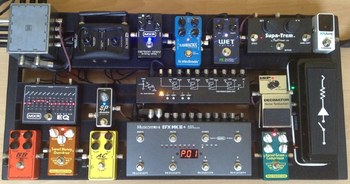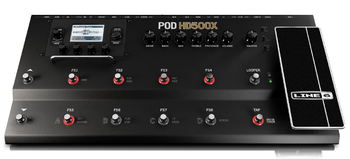Unless you're one of those guitarists or bassists who flat-out refuses to consider digital effects, it’s worth comparing the merits of multi-effects pedals with traditional pedalboard setups, before deciding which type to buy. The purpose here is not to advocate either option, but just to present the advantages and disadvantages of each.
In this corner
First, let’s look at the traditional approach: individual stompboxes connected together with short patch cables, sitting on a purchased (or self-constructed) pedalboard with a built-in or added-on power supply. For the sake of this article, I’m going call this type of setup a “traditional pedalboard.”
There are plenty of advantages to it: You have absolute freedom to choose any pedals that you want (taking into account your budget, of course), and, if you have enough room, you can add more, and you can change pedals in the future.
I have no statistical evidence for the following assertion, but I think it’s a pretty safe bet to say that guitarists in high-level acts, those who have roadies to setup and maintain their gear, overwhelmingly choose the traditional pedalboard approach. You get to configure where each pedal goes, and the order of the effects. If you stick with high-quality pedals and decent cables, you can assume you’ll have excellent sound quality, notwithstanding the quality of your amp and instrument.
You can also choose whether you want all analog effects, or a combination of analog and digital; and you can get effects with true-bypass capabilities to help keep your signal as pristine as possible when individual effects are turned off.
Bring on the challenger
On the other hand, it’s hard to argue that you won’t get more sonic variety with a multi-effects pedal. For example, the Line 6 POD HD500X (pictured below) offers more than 100 different effects to choose from (eight simultaneously). A traditional pedalboard with that many effects would take up an entire stage, and you might have to run 10 feet to get from your distortion to your chorus pedal (and good luck fitting it in your car).
But, of course, quality trumps quantity, and that for a long time was the Achilles heel of multi-effects pedals. Traditional pedalboards simply sounded better. Although some musicians might not agree, the differences in sound quality are not nearly what they once were. Today’s multi-effects pedals feature 24-bit digital audio and utilize modeling technology, and many sound surprisingly good.
Every multi-effects pedal has a built-in tuner, and most include a pedal (or pedals) for controlling wah, volume, or other parameters. Both a tuner and a pedal would be separate purchases for a traditional pedalboard owner, and you’d probably have to buy separate wah and volume pedals if you wanted both. Multi-effects pedals tend to be lighter, smaller and easier to setup and take down than traditional pedalboards. They also allow you to save your settings, so you could have a custom preset, with a custom effects lineup for every song your band plays.
Most modern multi-effects pedals also offer amp modeling, which gives you added flexibility: if your amp breaks down at a show, or you’re in a situation where you can’t bring it to your gig for whatever reason, you could plug directly into the PA with just your multi-effects pedal and still sound like you’re going through am amp. It won’t be exactly the same experience, but if there’s a reasonably decent monitor setup at the venue, it will get you through the gig. What’s more, you can also use the amp modeling and effects, plugged in direct when recording. With a traditional pedalboard, you have to go through an amp in all cases.
Betwixt and between
If you want some of the advantages of both approaches, there are hybrid products, like the Carl Martin Quattro or the soon-to-be-released Tech 21 Fly Rig 5 (see below), which offer multi-effects in an all-analog unit. They don’t have many of the conveniences of digital multi-effects pedals, such as the ability to save presets or to get updates via a computer.
Face to face
So now that I’ve outlined the basic characteristics of the two types of setups, let’s compare pros and cons of the two approaches, which should give you a good idea of what you can expect from either type of setup.
| Traditional Pedalboard | Multi-Effects Pedal |
|---|---|
| PROS | PROS |
| Sound quality considered superior if you use good-quality pedals | More available effects at your disposal and less expensive per effect by far |
| Completely customizable—you can mix and match pedals from any manufacturer | All-in-one unit, usually with a single AC cable |
| Expandable | Amp modeling features useful when no amp available or for recording |
| Flexible: you can swap effects in and out of your rig depending on your needs, and bring less effects on gigs where you want a simpler setup | Faster setup and takedown, fewer cables involved |
| You can have a completely analog signal path if desired | Typically smaller, so takes up less stage space and easier to carry |
| Much easier to tweak onstage than most digital units | No patch cables needed between effects |
| Longer lasting, as you can replace individual pedals as they wear out | Digital memory allows for saving of custom presets |
| Effects order can be changed at will | Many units allow connection to computer for firmware updates |
| Tuner and usually a volume/wah pedal built in | |
| CONS | CONS |
| Typically a more expensive way to go | Many will consider the sound quality to be inferior to a high-quality traditional pedalboard setup |
| Requires more maintenance | No control over what effects are included |
| Bulkier | May or may not be able to change effects order |
| Not only do you need to buy the effects themselves, but a pedalboard to hold them, and a power supply and patch cables | If something breaks, the entire unit will have to go to the repair shop |
| Typically not as easy to tweak quickly during a song |
So there you go. There are clearly merits to both approaches, and which one you take depends on your needs, budget and taste. Feel free to chime in via the comments section with additional pros and cons, and to voice your opinion on which type of setup you prefer, because I’m sure this is a subject that some people feel pretty strongly about. Have at it!



